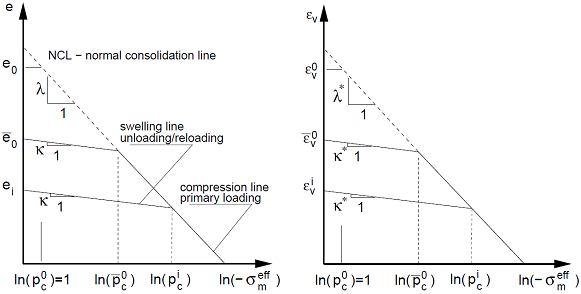Generalized Cam-Clay Model (GCC)
This model represents a considerable improvement of the Modified Cam clay (MCC) model, particularly when modeling soils in the supercritical domain, see Figure, where the failure surface follows the classical models of Mohr-Coulomb, Drucker-Prager and Modified Mohr-Coulomb models. Unlike the Modified Cam clay model (dashed line) the GCC model plots, similarly to the MMC model, as a rounded triangle in the deviatoric plane. The MCC model plots, similarly to the Drucker-Prager model, as a circle. In the subcritical domain both models behave identically. Upon unloading, a linear response of soil is assumed. GCC model is available only when advanced program options are on. Reliable initialization of the model is described in section "Numerical implementation of MCC and GCC models".
 Projection of yield surface of MCC and GCC models into meridial and deviatoric planes
Projection of yield surface of MCC and GCC models into meridial and deviatoric planes
The material parameters required for the Generalized Cam clay model are identical to the material data of MCC and MMC models:
κ | - | slope of swelling line |
λ | - | slope of normal consolidation line (NCL) |
e0 | - | initial void ratio |
OCR | - | overconsoliodation ratio |
c | - | cohesion |
φ | angle of internal friction | |
φcv | angle of internal friction at constant volume [-] | |
ν | Poisson's ratio |
Parameters κ and λ can be estimated from the following expressions:
![]()
![]()
where: | Cc | - | one-dimensional compression index |
Cs | - | one-dimensional swelling index |
These parameters follow from a simple oedometric test.
Similarly to the MCC model the formulation of the GCC model is based on the relation between the void ratio (volumetric strain) and the mean effective stress as shown in the following Figure. Both graphs are linked as follows:
![]()
![]()
 Response of material during isotropic compression (constitutive law)
Response of material during isotropic compression (constitutive law)
Evolution of the yield surface (hardening/softening) is driven by the current preconsolidation pressure pc.

where: |
| - | current preconsolidation pressure |
| - | increment of volumetric plastic strain |